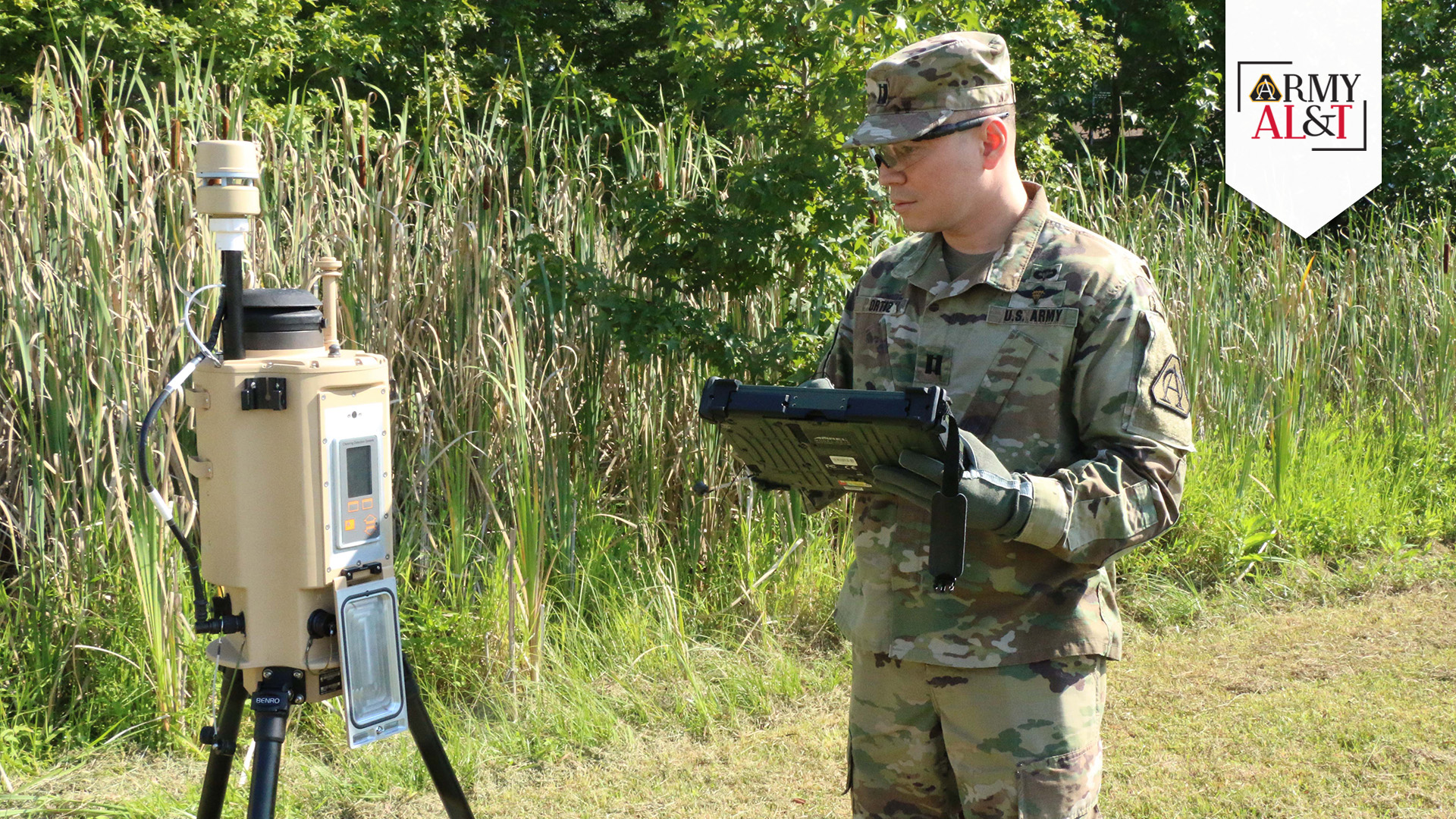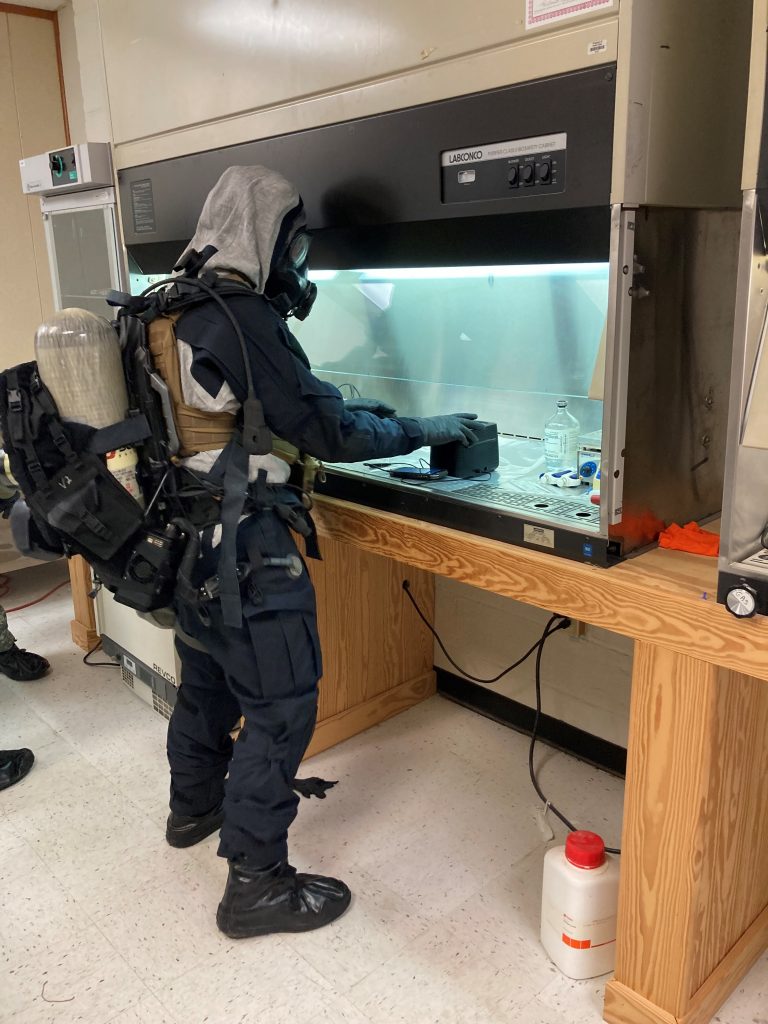
TAKING NO RISKS: U.S. Marines from the Chemical & Biological Incident Response Force (CBIRF) participate in a Product Manager Risk Reduction activity at Aberdeen Proving Ground, Maryland in October 2023. (Photos courtesy of JPEO-CBRND)
The Joint Biological Tactical Detection System is ready to go into production.
by Jack Wilson and Alexandra Hillman
It’s been 20 years in the making, but the Army is about to get its first lightweight, low-cost, man-portable defense surveillance system for detecting, collecting and identifying biological warfare agent aerosols.
First conceived in 2003, the Joint Biological Tactical Defense System (JBTDS), a project developed under the Joint Program Executive Office for Chemical, Biological, Radiological and Nuclear Defense (JPEO-CBRND), has finally achieved Milestone C, passing a critical point in the acquisition process and moving the capability forward into production and deployment.
The JBTDS will provide the CBRN community with real-time awareness of potential hazards in various operational environments without the logistical burden of being mounted on a vehicle or trailer.
Biological detection and identification is complex and presents significant challenges. Why? Because the diverse range of biological threats out there including bacteria, viruses and toxins, makes it difficult to develop universal detection methods. Each biological agent requires specific detection protocols, and the constantly evolving nature of biological warfare necessitates continuous adaptation and innovation. As these novel agents are realized, continuous evolution and improvement of assay panels will keep pace with the threat and respond with medical countermeasures, as needed.

NECESSARY PREPARATIONS: U.S. Marines from the CBIRF participated in a Product Manager Risk Reduction activity at Aberdeen Proving Ground, Maryland in October 2023. Product managers often conduct excursions with operational units to identify potential risks to performance as well as document warfighter experiences using the equipment prior to undergoing further testing.
FILLING A SIMPLE BUT AMBITIOUS NEED
The JBTDS first emerged from the pressing need to enhance the U.S. military’s capabilities for the detection, identification and characterization of biological threats during Operation Iraqi Freedom and Operation Enduring Freedom. The idea was simple yet ambitious: create a man-portable integrated system, no heavier than 45 pounds, capable of rapidly identifying and responding to biological agents in operational environments across the globe. The result would be a system powerful enough to detect biological hazards but also small and light enough that the warfighter could still freely maneuver.
Developing a sophisticated tactical biological detection and identification system from scratch presented numerous challenges. Developers underwent many operational demonstrations and experiments with multiple prototypes to inform the Joint Requirements Office (JRO) and help determine what capability might be possible—and with what features. This technology had not yet been explored on the commercial side, making it a true need for DOD to spearhead its development.
Recognizing the importance of this effort and the clear requirement to protect the joint force from emerging threats, JBTDS stakeholders went to work.
Although it would take 20 years to fully develop the system, there were many technical and programmatic delays that the team had to address and overcome during this period. For starters, team members needed to refine the technology by developing a new detection modality that operated with a battery able to withstand temperature extremes. Then, the team’s work was delayed by a two-year moratorium on biological work, starting in 2015. Finally, the team had to overcome technical challenges with the detector, which led to the assessment of multiple solutions during the Biological Point System Assessment in 2018-2019. It was no small feat and took considerable time to overcome these challenges; however, the JBTDS is stronger and more precise because of navigating the ups and downs of advanced development.
It led to greater interoperability with and communication between CBRN sensor instruments in austere environments, for example. The JPEO-CBRND’s Joint Project Manager (JPM) for CBRN Sensors team was also able to forge partnerships with other Program Executive Offices and project managers to ensure that cyber compliance and security was not compromised; among their accomplishments was a comprehensive Cyber Security Strategy, a first for a biological sensor within the JPEO-CBRND portfolio. Additionally, the team coordinated numerous requirements across the services to verify that all branches had their CBRN detection and identification needs met.
Upon completion of the technology’s experimentation and demonstration, a validated Capability Development Document was endorsed by the JRO Counsel in 2014, indicating that the capability met the requirements set forth by DOD to protect and defend warfighters downrange.
A defining aspect of the JBTDS project has been the collaboration among various U.S. government agencies. JPEO-CBRND played a pivotal role in bringing together experts from different domains to foster the development of this much-needed detection capability. For example, the U.S. Army Combat Capabilities Development Command’s (DEVCOM) Chemical Biological Center (CBC) provided crucial technological advancements using its cutting-edge research capabilities and ingenuity to design a biological warfare agent trigger and detector that could be integrated with the JBTDS.
DEVCOM CBC contributed its vast biological detection experience, while the Defense Threat Reduction Agency’s Joint Science and Technology Office, which, along with the JPEO-CBRND and JRO is part of the larger Chemical and Biological Defense Program (CBDP) and a science and technology development partner of the JPEO-CBRND, lent expertise in emerging and novel threats. Meanwhile, the CBDP’s JRO assisted in navigating the joint capabilities integration and development system process, which defines DOD acquisition requirements and evaluation criteria, even as other stakeholders worked to qualify the system.

FIRST OF ITS KIND: U.S. Special Operations Command Soldiers conducted simulation testing on the Biomeme 3/9 Integrated Sample Prep (ISP) JBTDS Identifier at Joint Expeditionary Base Little Creek-Fort Story, Virginia in October 2022. This device is the first of its kind to provide polymerase chain reaction (PCR) identification, where warfighters can identify a pathogen at the point of collection rather than transporting samples to laboratories.
A GAME CHANGER
The JBTDS offers several advantages that make it a game changer in the field of biological threat detection. First, the system provides real-time detection and identification of biological agents, allowing for swift and informed responses to potential threats. The system is also versatile, so it can be used on a wide range of operational environments, from military deployments to homeland security and disaster response scenarios.
The product’s reliability, availability and maintainability (RAM) sets it apart as well. Extensive testing and end-user feedback has been used to enhance the system’s performance to ensure its RAM will meet mission requirements, making it a more sustainable tool. Additionally, the system’s reliability supplies the warfighter with confidence in the results. Finally, the CBDP will continue to collaborate with interested stakeholders to ensure that the JBTDS remains at the forefront of technology, through ongoing improvements and updates.
FINALLY—THE MILESTONE C ACCOMPLISHMENT
The project finally achieved Milestone C status in August 2023—a pinnacle accomplishment for the JPEO–CBRND and its JPM CBRN Sensors team. It represents a critical decision point, signifying that the system has undergone rigorous testing and evaluation, proving its readiness for production and deployment, and officially recognizing that it is prepared for the rigors of a multi-service operational test and evaluation. The milestone marked the culmination of 20 years of hard work and cooperation from countless stakeholders throughout the department, ultimately equipping the joint force with a key bio-detection capability to ensure warfighters are safer in CBRN-contested environments.
“The JBTDS achieving Milestone C is a testament to the dedication and unwavering commitment of many stakeholders over the years and stands as an example of overcoming acquisition challenges,” said Col. Robert Carter, the previous joint project manager for CBRN Sensors. “Although we have come this far, the innovation required to stay the course and deploy this capability is still very much at the forefront.”

JBTDS SAMPLING: During a Product Manager Risk Reduction event at Aberdeen Proving Ground in October 2023, a Marine from CBIRF prepares a sample obtained from the JBTDS Detector/Collector for PCR identification using the Biomeme 3/9 ISP identifier.
MOVING FORWARD
With Milestone C achieved, the JBTDS is now positioned for Full Rate Production within the next 24 to 30 months. However, the JBTDS’ journey is far from over. JPM CBRN Sensors will continue to improve the system’s identification capability over the next 18 months.
Since entering Milestone C, the JBTDS has shown improvement in identifying biological warfare agents at both low and high concentrations while undergoing testing at Dugway Proving Ground, Utah. Based on preliminary data, it is projected that the identifier will meet the full threshold requirement in fiscal year 2026. The capability deployed to the force will be operationally effective and provide commanders confidence to make informed decisions to prevent or mitigate biological threats that may affect their troops.
In parallel, the JBTDS will continue to adapt to emerging threats and changing operational environments using an incremental approach to provide operationally relevant capability as threats and technologies evolve. JBTDS is poised to integrate into CBRN Support to Command and Control (CSC2), the JPEO–CBRND’s first approved DOD Software Acquisition Pathway program. This will allow commanders to maintain battlefield situational awareness at all echelons of command, while also helping to enable a full CBRN Integrated Layered Defense.
Warfighters using the JBTDS need confidence in the system’s ability to provide early warning in the event of an alarm. However, JBTDS users must also be aware of the concealment tactics used by adversaries that have the potential to further complicate their detection.
Biological agents can be dispersed covertly, making their detection and identification challenging, especially in large open environments such as rural battlefields and urban areas. The onset of symptoms in biological warfare victims often delays detection until after exposure has occurred, heightening the urgency of accurate and timely identification.
As a result, the CBDP must balance the need for effective detection and identification while managing the risk of false alarms. Balancing specificity versus sensitivity can be a true challenge. Both are critical to gaining an accurate result, but finding the balance is what matters most.
CONCLUSION
The development journey of the JBTDS is a testament to the power of collaboration, dedication and innovation in the pursuit of successful CBRN sensor development. The combined efforts of the entire CBRN defense community have resulted in a cutting-edge system that will enhance our nation’s capabilities to detect and respond to biological threats. As the JBTDS moves closer to full deployment and as warfighters incorporate this capability into their CBRN defense toolbox, it stands as a symbol of what can be achieved when organizations come together with a shared vision of protecting our nation against “the invisible threat.”
For more information about the JPEO-CBRND, go to https://www.jpeocbrnd.osd.mil/ or follow JPEO-CBRND on social media @JPEOCBRND. Questions about the article can be directed to usarmy.apg.dod-jpeo-cbrnd.mbx.public-affairs@army.mil.
JACK WILSON is the project manager for Integration, Interoperability and Services with the Program Executive Office for Command, Control and Communications-Tactical. He previously held the role of joint product director for JPEO-CBRND’s JPM CBRN Sensors’ Biological Detection Systems portfolio. An acquisition professional with 15 years of experience, he is DAWIA Certified Advanced in project management and a Practitioner in business financial management. He holds an M.S. in systems engineering project management and a B.S. in business administration and communication, both from the University of Maryland.
ALEXANDRA HILLMAN is the public affairs officer for JPEO-CBRND at Aberdeen Proving Ground – Edgewood, Maryland. She holds a Master of Public Health in health policy and management and a Master of Public Policy and Administration from the University of Massachusetts, Amherst and a Bachelor of Fine Arts in dance from Ohio University.







